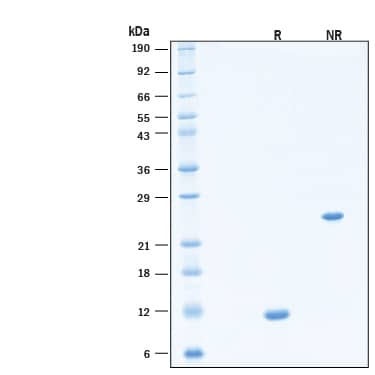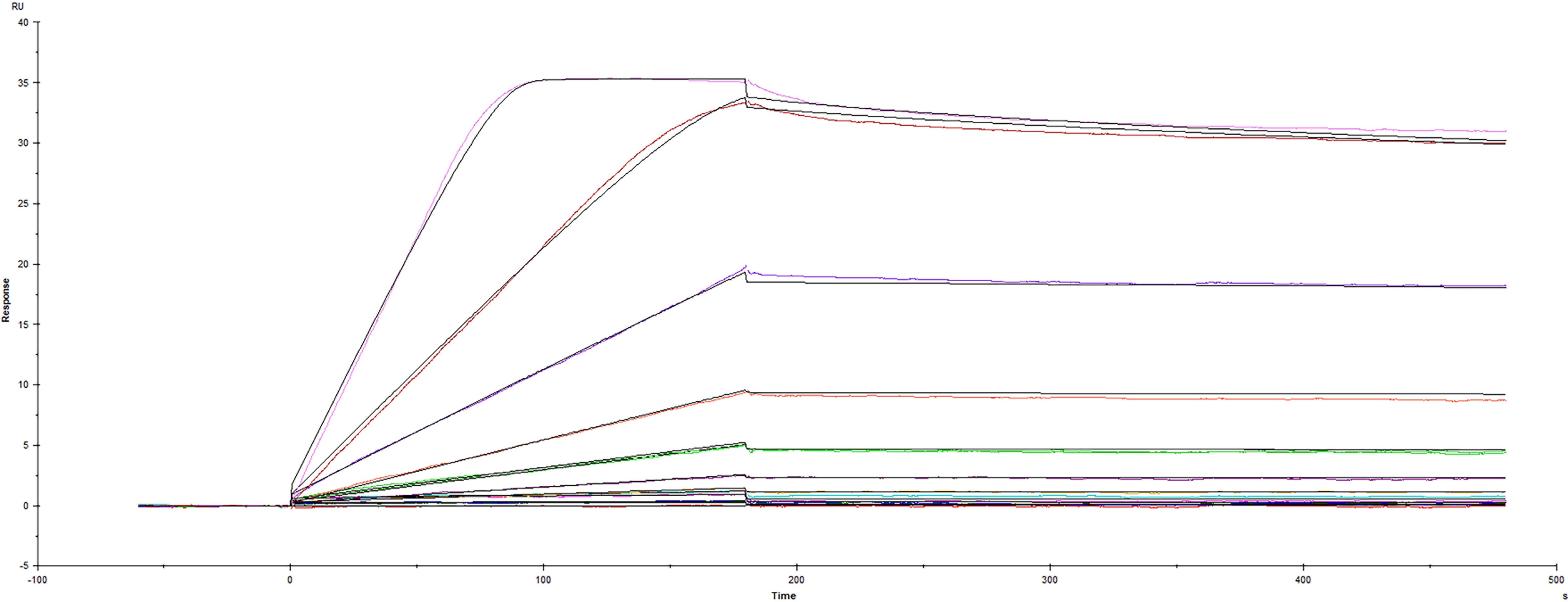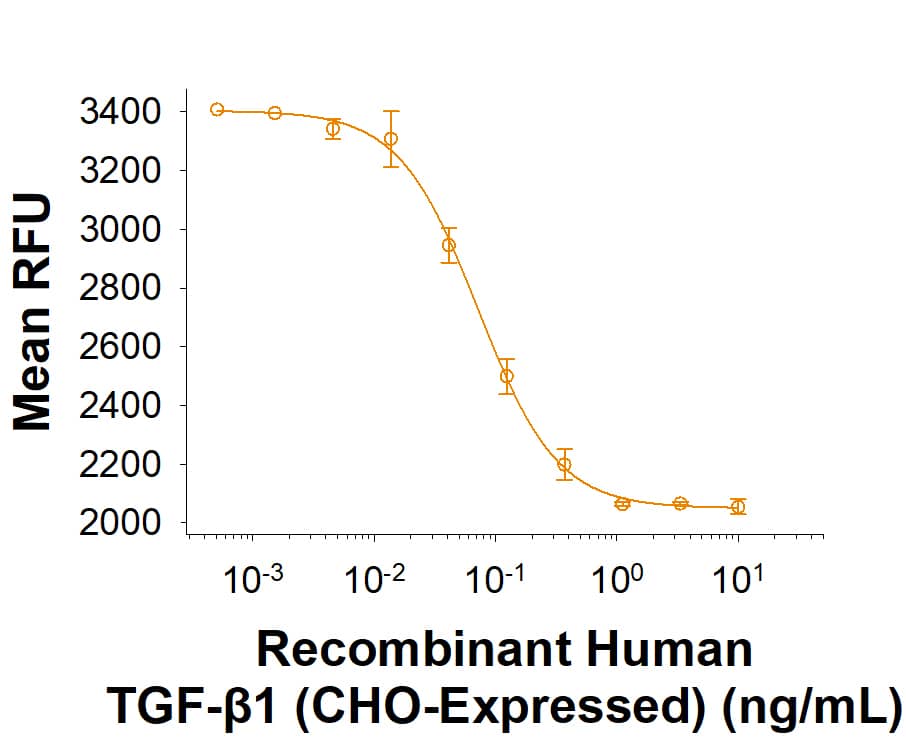Recombinant Human TGF-beta 1 (CHO-Expressed) Protein, CF Best Seller
R&D Systems, part of Bio-Techne | Catalog # 11409-BH

Key Product Details
Source
CHO
Accession #
Structure / Form
Disulfide-linked homodimer
Conjugate
Unconjugated
Applications
Bioactivity
Product Specifications
Source
Chinese Hamster Ovary cell line, CHO-derived human TGF-beta 1 protein
Ala279-Ser390
Ala279-Ser390
Purity
>97%, by SDS-PAGE visualized with Silver Staining and quantitative densitometry by Coomassie® Blue Staining.
Endotoxin Level
<0.10 EU per 1 μg of the protein by the LAL method.
N-terminal Sequence Analysis
Ala279
Predicted Molecular Mass
13 kDa
SDS-PAGE
12 kDa, under reducing conditions & 24 kDa under non-reducing conditions.
Activity
Measured by its ability to inhibit the IL-4-dependent proliferation of HT-2 mouse T cells. Tsang, M. et al. (1995) Cytokine 7:389.
The ED50 for this effect is 0.025-0.200 ng/mL.
The ED50 for this effect is 0.025-0.200 ng/mL.
Scientific Data Images for Recombinant Human TGF-beta 1 (CHO-Expressed) Protein, CF
Recombinant Human TGF‑ beta1 (CHO-Expressed) Protein Bioactivity.
Recombinant Human TGF‑ beta1 (CHO-Expressed) (Catalog # 11409-BH) inhibits recombinant mouse IL-4 induced proliferation in the HT-2 mouse T cell line. The ED50 for this effect is 0.025-0.200 ng/mL.Recombinant Human TGF‑ beta1 (CHO-Expressed) Protein SDS-PAGE.
2 μg/lane of Recombinant Human TGF‑ beta1 (CHO-Expressed) Protein (Catalog # 11409-BH) was resolved with SDS-PAGE under reducing (R) and non-reducing (NR) conditions and visualized by Coomassie® Blue staining, showing bands at 12 kDa, under reducing conditions & 24 kDa under non-reducing conditions.Affinity Measurements and Binding Kinetics of the Interaction between TGF-beta RII and TGF beta1 by SPR
Recombinant Human TGF-beta RII Fc Chimera (341-BR) was was captured on a Sensor Chip Protein AGL, and binding to Recombinant Human TGF beta1 (11409-BH) was measured at a concentration range between 0.488 pM and 1000 pM. The double-referenced sensorgram was fit to a 1:1 binding model to determine the binding kinetics and affinity, with an affinity constant of KD=3.076 pM. (Biacore T200).Formulation, Preparation and Storage
11409-BH
| Formulation | Lyophilized from a 0.2 μm filtered solution in Acetonitrile and TFA with Trehalose. |
| Reconstitution | Reconstitute the 10 μg size at 100 μg/mL in 4mM HCl. Reconstitute all other sizes at 250 μg/mL in 4mM HCl. |
| Shipping | The product is shipped at ambient temperature. Upon receipt, store it immediately at the temperature recommended below. |
| Stability & Storage | Use a manual defrost freezer and avoid repeated freeze-thaw cycles.
|
Background: TGF-beta 1
References
- Derynck, R. and K. Miyazono (2008) Cold Spring Harbor Laboratory Press p. 29.
- Dunker, N. and K. Krieglstein (2000) Eur. J. Biochem. 267:6982.
- Wahl, S.M. (2006) Immunol. Rev. 213:213.
- Chang, H. et al. (2002) Endocr. Rev. 23:787.
- Lin, J.S. et al. (2006) Reproduction 132:179.
- Hinck, A.P. et al. (1996) Biochemistry 35:8517.
- Mittl, P.R.E. et al. (1996) Protein Sci. 5:1261.
- Derynck, R. et al. (1985) Nature 316:701.
- Miyazono, K. et al. (1988) J. Biol. Chem. 263:6407.
- Oklu, R. and R. Hesketh (2000) Biochem. J. 352:601.
- de Caestecker, M. et al. (2004) Cytokine Growth Factor Rev. 15:1.
- Zuniga, J.E. et al. (2005) J. Mol. Biol. 354:1052.
Long Name
Transforming Growth Factor beta 1
Alternate Names
TGF beta1, TGFB, TGFB1, TGFbeta 1
Gene Symbol
TGFB1
UniProt
Additional TGF-beta 1 Products
Product Documents for Recombinant Human TGF-beta 1 (CHO-Expressed) Protein, CF
Product Specific Notices for Recombinant Human TGF-beta 1 (CHO-Expressed) Protein, CF
For research use only
